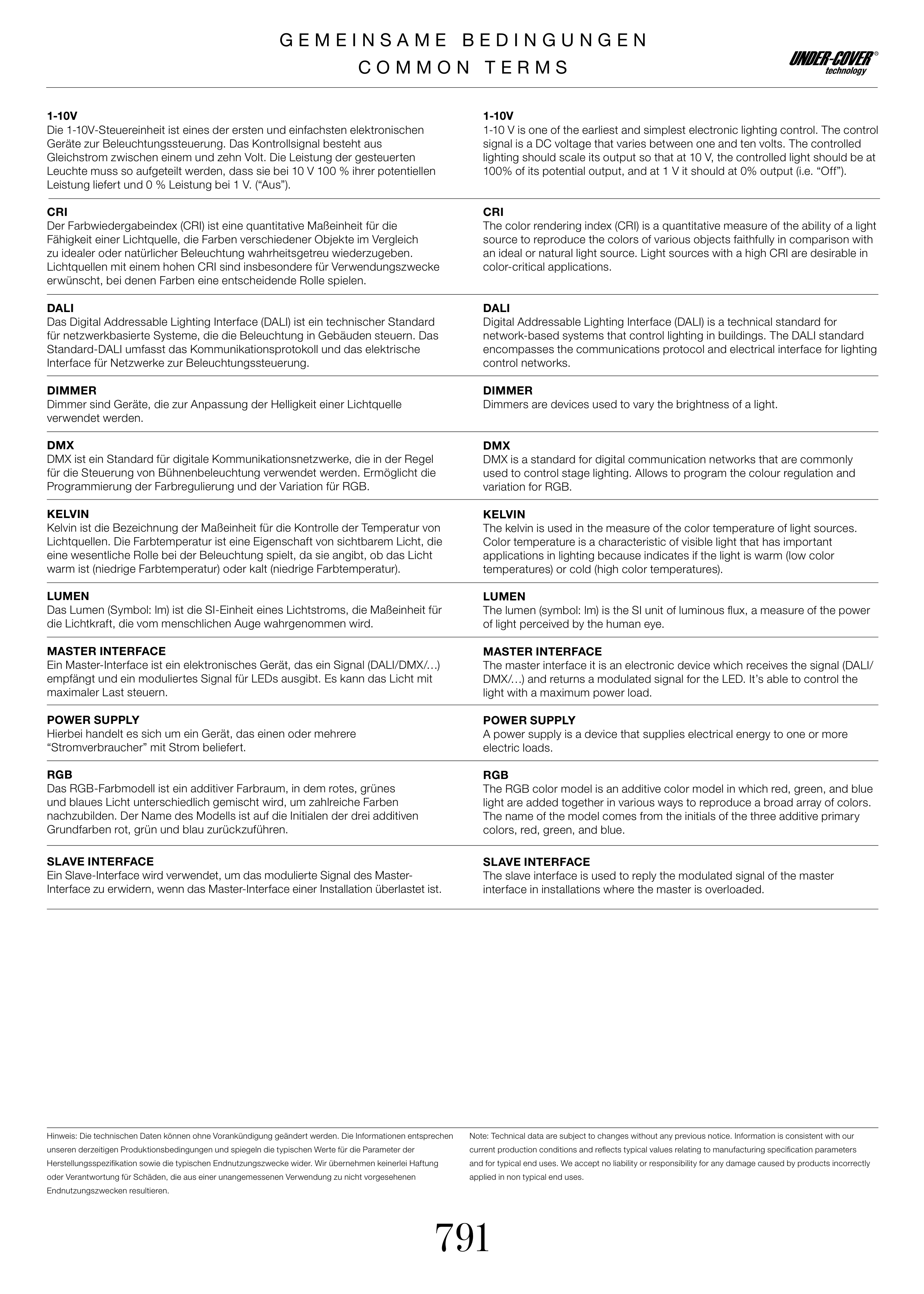791
technology
1-10V
1-10 V is one of the earliest and simplest electronic lighting control. The control
signal is a DC voltage that varies between one and ten volts. The controlled
lighting should scale its output so that at 10 V, the controlled light should be at
100% of its potential output, and at 1 V it should at 0% output (i.e. “Off”).
CRI
The color rendering index (CRI) is a quantitative measure of the ability of a light
source to reproduce the colors of various objects faithfully in comparison with
an ideal or natural light source. Light sources with a high CRI are desirable in
color-critical applications.
DALI
Digital Addressable Lighting Interface (DALI) is a technical standard for
network-based systems that control lighting in buildings. The DALI standard
encompasses the communications protocol and electrical interface for lighting
control networks.
DIMMER
Dimmers are devices used to vary the brightness of a light.
DMX
DMX is a standard for digital communication networks that are commonly
used to control stage lighting. Allows to program the colour regulation and
variation for RGB.
KELVIN
The kelvin is used in the measure of the color temperature of light sources.
Color temperature is a characteristic of visible light that has important
applications in lighting because indicates if the light is warm (low color
temperatures) or cold (high color temperatures).
LUMEN
The lumen (symbol: lm) is the SI unit of luminous flux, a measure of the power
of light perceived by the human eye.
MASTER INTERFACE
The master interface it is an electronic device which receives the signal (DALI/
DMX/…) and returns a modulated signal for the LED. It’s able to control the
light with a maximum power load.
POWER SUPPLY
A power supply is a device that supplies electrical energy to one or more
electric loads.
RGB
The RGB color model is an additive color model in which red, green, and blue
light are added together in various ways to reproduce a broad array of colors.
The name of the model comes from the initials of the three additive primary
colors, red, green, and blue.
SLAVE INTERFACE
The slave interface is used to reply the modulated signal of the master
interface in installations where the master is overloaded.
Hinweis: Die technischen Daten können ohne Vorankündigung geändert werden. Die Informationen entsprechen
unseren derzeitigen Produktionsbedingungen und spiegeln die typischen Werte für die Parameter der
Herstellungsspezifikation sowie die typischen Endnutzungszwecke wider. Wir übernehmen keinerlei Haftung
oder Verantwortung für Schäden, die aus einer unangemessenen Verwendung zu nicht vorgesehenen
Endnutzungszwecken resultieren.
1-10V
Die 1-10V-Steuereinheit ist eines der ersten und einfachsten elektronischen
Geräte zur Beleuchtungssteuerung. Das Kontrollsignal besteht aus
Gleichstrom zwischen einem und zehn Volt. Die Leistung der gesteuerten
Leuchte muss so aufgeteilt werden, dass sie bei 10 V 100 % ihrer potentiellen
Leistung liefert und 0 % Leistung bei 1 V. (“Aus”).
CRI
Der Farbwiedergabeindex (CRI) ist eine quantitative Maßeinheit für die
Fähigkeit einer Lichtquelle, die Farben verschiedener Objekte im Vergleich
zu idealer oder natürlicher Beleuchtung wahrheitsgetreu wiederzugeben.
Lichtquellen mit einem hohen CRI sind insbesondere für Verwendungszwecke
erwünscht, bei denen Farben eine entscheidende Rolle spielen.
DALI
Das Digital Addressable Lighting Interface (DALI) ist ein technischer Standard
für netzwerkbasierte Systeme, die die Beleuchtung in Gebäuden steuern. Das
Standard-DALI umfasst das Kommunikationsprotokoll und das elektrische
Interface für Netzwerke zur Beleuchtungssteuerung.
DIMMER
Dimmer sind Geräte, die zur Anpassung der Helligkeit einer Lichtquelle
verwendet werden.
DMX
DMX ist ein Standard für digitale Kommunikationsnetzwerke, die in der Regel
für die Steuerung von Bühnenbeleuchtung verwendet werden. Ermöglicht die
Programmierung der Farbregulierung und der Variation für RGB.
KELVIN
Kelvin ist die Bezeichnung der Maßeinheit für die Kontrolle der Temperatur von
Lichtquellen. Die Farbtemperatur ist eine Eigenschaft von sichtbarem Licht, die
eine wesentliche Rolle bei der Beleuchtung spielt, da sie angibt, ob das Licht
warm ist (niedrige Farbtemperatur) oder kalt (niedrige Farbtemperatur).
LUMEN
Das Lumen (Symbol: lm) ist die SI-Einheit eines Lichtstroms, die Maßeinheit für
die Lichtkraft, die vom menschlichen Auge wahrgenommen wird.
MASTER INTERFACE
Ein Master-Interface ist ein elektronisches Gerät, das ein Signal (DALI/DMX/…)
empfängt und ein moduliertes Signal für LEDs ausgibt. Es kann das Licht mit
maximaler Last steuern.
POWER SUPPLY
Hierbei handelt es sich um ein Gerät, das einen oder mehrere
“Stromverbraucher” mit Strom beliefert.
RGB
Das RGB-Farbmodell ist ein additiver Farbraum, in dem rotes, grünes
und blaues Licht unterschiedlich gemischt wird, um zahlreiche Farben
nachzubilden. Der Name des Modells ist auf die Initialen der drei additiven
Grundfarben rot, grün und blau zurückzuführen.
SLAVE INTERFACE
Ein Slave-Interface wird verwendet, um das modulierte Signal des Master-
Interface zu erwidern, wenn das Master-Interface einer Installation überlastet ist.
G E M E I N S A M E B E D I N G U N G E N
C O M M O N T E R M S
Note: Technical data are subject to changes without any previous notice. Information is consistent with our
current production conditions and reflects typical values relating to manufacturing specification parameters
and for typical end uses. We accept no liability or responsibility for any damage caused by products incorrectly
applied in non typical end uses.


